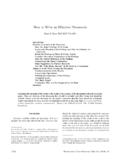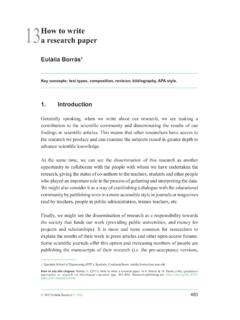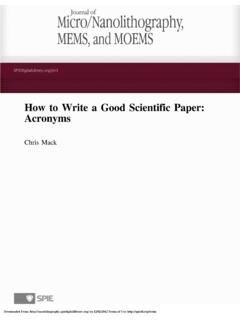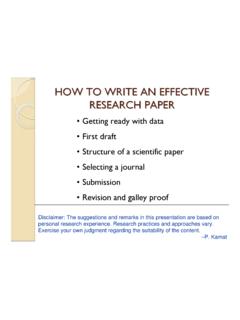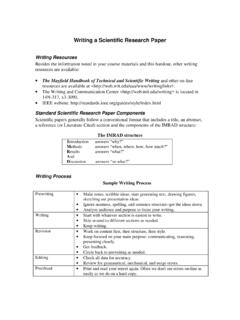Transcription of How to Write the Methods Section of a Research Paper
1 How to Write the Methods Section of a Research PaperRichard H Kallet MSc RRT FAARCI ntroductionBasic Research ConceptsContent and Writing Style of the Methods SectionSubjectsEthical ConsiderationsPreparationsProtocol DesignMeasurements and CalculationsData AnalysisSummaryThe Methods Section of a Research Paper provides the information by which a study s validity is , it requires a clear and precise description of how an experiment was done, and the rationalefor why specific experimental procedures were chosen. The Methods Section should describe what wasdone to answer the Research question, describe how it was done, justify the experimental design, andexplain how the results were analyzed. scientific writing is direct and orderly. Therefore, themethods Section structure should: describe the materials used in the study, explain how thematerials were prepared for the study, describe the Research protocol, explain how measure-ments were made and what calculations were performed, and state which statistical tests weredone to analyze the data.
2 Once all elements of the Methods Section are written, subsequentdrafts should focus on how to present those elements as clearly and logically as possibly. Thedescription of preparations, measurements, and the protocol should be organized chronologi-cally. For clarity, when a large amount of detail must be presented, information should bepresented in sub-sections according to topic. Material in each Section should be organized bytopic from most to least words: publications; Research ; Research methodology;clinical trials; laboratory Research ; writing; mauscripts, medical. [Respir Care 2004;49(10):1229 1232. 2004 Daedalus Enterprises]IntroductionThe Methods Section is the most important aspect of aresearch Paper because it provides the information by whichthe validity of a study is ultimately judged. Therefore, theauthor must provide a clear and precise description of howan experiment was done, and the rationale for the specificexperimental procedures chosen.
3 It must be written withenough information so that: (1) the experiment could berepeated by others to evaluate whether the results are re-producible, and (2) the audience can judge whether theresults and conclusions are valid. In this article I describeRichard H Kallet MSc RRT FAARC is affiliated with the CardiovascularResearch Institute, and with Respiratory Care Services, Department ofAnesthesia, San Francisco General Hospital, University of California,San Francisco, H Kallet MS RRT FAARC presented a version of this article atthe RESPIRATORYCAREJ ournal symposium, Anatomy of a ResearchPaper: Science Writing 101, at the 48th International Respiratory Con-gress, held October 5 8, 2002, in Tampa, : Richard H Kallet MS RRT FAARC, Respiratory CareServices, San Francisco General Hospital, NH:GA-2, 1001 Potrero Av-enue, San Francisco CA. 94110. E-mail: OCTOBER2004 VOL49 NO101229one approach to writing the Methods Section .
4 Because thissection is so intimately related to the principles of scien-tific Research , I begin with a review of basic researchconcepts, and then follow with a discussion of importantpoints to incorporate when writing the Methods Research ConceptsThe scientific method attempts to discover cause-and-effect relationships between objects (ie, physical matter orprocesses). In the physical sciences objects are regarded asvariables, and a variable is anything that can assume dif-ferent values. Elucidating a cause-and-effect relationshipbetween objects requires that variables are classified asindependent, dependent, or confounding. Anindependentvariableis one that, when manipulated, causes a change inanother variable. The variable that changes in response tothat manipulation is referred to as adependent example, arterial oxygen tension is a dependent vari-able that responds to manipulations in independent vari-ables such as barometric pressure and oxygen concentra-tion.
5 Aconfoundingor extraneous variable is anythingother than the independent variable of interest that mayaffect the dependent variable. Therefore, a change in adependent variable may be due wholly or in part to achange in a confounding variable. For example, a changein minute ventilation can alter arterial oxygen tension byits effect upon alveolar carbon dioxide partial of a potential cause-effect relationship be-tween 2 objects is accomplished through the developmentof the study design. A study design is simply a strategy tocontrol and manipulate variables that provide an answer tothe Research question regarding potential refers to the credibility of experimental resultsand the degree to which the results can be applied to thegeneral population of validityrefers tothe credibility of a study and is determined by the degreeto which conclusions drawn from an experiment correctlydescribe what actually transpired during the validityrefers to whether (and to what degree) theresults of a study can be generalized to a larger , all biological systems are profoundlycomplex, so simple, unambiguous, direct relationships be-tween objects can be difficult to ascertain.
6 The internalvalidity of a study is judged by the degree to which itsoutcomes can be attributed to manipulation of independentvariables and not to the effects of confounding , the study protocol must be designed to control(eg, to keep constant) as many extraneous factors as pos-sible so that any potential cause-and-effect relationshipbetween 2 objects can be judged accurately. It is importantto emphasize that confounding variables can never be fullycontrolled. Furthermore, the influence of these variablesmay not be fully appreciated by those conducting the re-search. External validity is primarily determined by howsubjects are selected to participate in a study and by theuse of randomization procedures that limit potential bias inhow subjects are assigned to treatment and Writing Style of the Methods SectionHistorically, the Methods Section was referred to as the materials and Methods to emphasize the 2 distinct areasthat must be addressed.
7 Materials referred to what wasexamined (eg, humans, animals, tissue preparations) andalso to the various treatments (eg, drugs, gases) and in-struments (eg, ventilators) used in the study. Methods referred to how subjects or objects were manipulated toanswer the experimental question, how measurements andcalculations were made, and how the data were complexity of scientific inquiry necessitates thatthe writing of the Methods be clear and orderly to avoidconfusion and ambiguity. First, it is usually helpful tostructure the Methods Section by:1. Describing the materials used in the study2. Explaining how the materials were prepared3. Describing the Research protocol4. Explaining how measurements were made and whatcalculations were performed5. Stating which statistical tests were done to analyzethe data2 Second, the writing should be direct and precise and inthe past tense. Compound sentence structures should beavoided, as well as descriptions of unimportant all elements of the Methods Section are written downduring the initial draft, subsequent drafts should focus onhow to present those elements as clearly and logically aspossibly.
8 In general, the description of preparations, mea-surements, and the protocol should be organized chrono-logically. For clarity, when a large amount of detail mustbe presented, information should be presented in subsec-tions according to topic. Within each Section and subsec-tion, material should always be organized by topic frommost to least the external validity of a study involving hu-man subjects (ie, to whom the study results may be ap-plied) requires that descriptive data be provided regardingthe basic demographic profile of the sample population,including age, gender, and possibly the racial compositionof the sample. When animals are the subjects of a study, itis important to list species, weight, strain, sex, and TOWRITE THEMETHODSSECTION OF ARESEARCHPAPER1230 RESPIRATORYCARE OCTOBER2004 VOL49 NO10 Who is chosen for inclusion in a study (as well as howtreatments are assigned) in large measure determines whatlimits are placed on the generalizations that can be maderegarding the study results.
9 Thus, when writing the meth-ods Section , it is important to describe who the subjectswerein the contextof the Research question. The selectioncriteria and rationale for enrolling patients into the studymust be stated explicitly. For example, if the study pro-claims to examine whether noninvasive ventilation reducesthe need for intubation of patients with cardiogenic pul-monary edema, then one would not anticipate that surgicalpatients with respiratory failure would be addition, it is important when describing patients toprovide some evaluation of their health status that is rel-evant to the study. For example, when examining therapiesthat may impact mortality in acutely ill patients, the studysubjects health status can be assessed with a scoring sys-tem such as the Simplified Acute Physiology patients in a rehabilitation setting, then a generalquality-of-life questionnaire such as the Sickness ImpactProfile can be ConsiderationsWhen working with human or animal subjects, theremust be a declaration that the medical center s institutionalreview board governing Research on living matter has de-termined that the study protocol adheres to ethical princi-ples.
10 Without such approval, no Research project can beconducted nor can it be published in a reputable, peer-review science studies involving animal models or mechanical mod-els, a detailed description must be provided regarding thepreparations made prior to beginning the experimental pro-tocol. In studies involving animals a detailed descriptionshould be provided on the use of sedation and anesthesia,the route of administration, and how its efficacy was addition, all aspects of animal or tissue prepa-ration required prior to initiation of the Research protocolmust be described in detail. With any animal preparationor mechanical model there must be enough detail providedso that the reader can duplicate it or evaluate its a study involves the use or evaluation of drugs, thegeneric drug name should be used and the manufacturer,concentration, dose, and infusion rate should be , when medical gases are used, the concentrationand flow rates should be is worth noting that the introduction of any novelmethod for measuring a variable, or preparing/designing amodel will require intense discussion.

